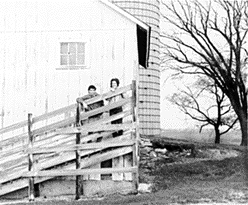GLIMPSE OF NEBRASKA
Nebraska has been a travel destination since at least the 18th century, when European pioneers passed through the region for the first time. Today, tourism is Nebraska's third leading earner of revenue from outside the state.
The Cornhusker State, as Nebraska is known, has 77,355 square miles of land, making it the 15th largest state in the U.S. It is bordered by South Dakota to the north, Iowa and Missouri to the east, Kansas to the south, and Colorado and Wyoming to the west. Nebraska has two major geographic regions: the Dissected Till Plains (in the east) and the Great Plains (in the west). The Dissected Till Plains were formed by an Ice Age glacier, which left behind rich soil suitable for farming. The Great Plains are home to the Sandhills, the largest sand dune area in North America. Grasses have grown out of these sand dunes, making the region useful for raising cattle. A section of the Badlands (found mainly in South Dakota) crosses Nebraska's northern border in two places. These areas contain unusual rock formations that were carved out by wind, rain and snow.
Nebraska experiences a variety of weather, including sunny skies and cool summer breezes, as well as tornadoes, thunderstorms, and blizzards. Temperature and precipitation decrease across the state from east to west. Spring and fall are generally pleasant in Nebraska.
The most prevalent native vegetation is grass, and more varieties are thought to grow here than in any other state. In the west, short grasses, such as buffalo grass, can be found. In the eastern part of the state, tall prairie grasses grow. Early white settlers realized the importance of nature conservation, and they began to plant trees. In 1872, Nebraska was the first state to establish an Arbor Day, and tree planting continues to this day. Common in the state are ash, willow, box elder, cottonwood, locust, oak, walnut, elm, pine and cedar trees. Also contributing to Nebraska's mix of plant life are wild plums, chokecherries, and a variety of flowers, such as larkspurs, columbines, wild roses, goldenrods, poppies and sunflowers.
Nebraska also has a variety of wildlife. The buffalo, important to the Native Americans and white settlers of the region, can still be found, mainly in game preserves. Other mammals in the state are beaver, deer, antelope, bobcat, fox, badger, coyote, squirrel, prairie dog, muskrat, skunk, raccoon, rabbit and opossum. Game birds such as pheasants, ducks, geese and quail are common in Nebraska. In the state's waters, one can find bass, carp, catfish, crappies, perch, pike, trout and walleye.

Before the white settlers came to the region, it was the home of several Native American tribes, including the Pawnee, Omaha, Oto, Ponca, Santee, Sioux, Dakota Sioux, Cheyenne, Potawatome, Arapahoe, Sac and Fox. Today, about 9,000 Native Americans live in Nebraska. Many of Nebraska's early white settlers were European immigrants, mostly from Germany, who sought free land under the U.S. Homestead Act of 1862. Other ethnic groups included the Swedes, Danes, Bohemians, Russians, Poles, French, Irish, English and Italians. Statewide railroad construction spurred development of many new communities. After the Civil War, many African Americans left the South and settled in Nebraska.
Recent census data show that 98 percent of the people living in Nebraska today were born in the United States. The state's ethnic mix includes Germans (39.9 percent), English (13.8 percent), Irish (11.3 percent), Swedes (6.7 percent), Czechs (5.3 percent), African Americans (3.6 percent), people of Native American descent (.07 percent), Asian Americans (.07 percent) and other races.
In 1990, the U.S. Bureau of the Census reported 1,578,385 people living in Nebraska. About four-fifths of Nebraskans live in the eastern third of the state, which includes Omaha, the largest city, with 335,795 people, and the capital city of Lincoln, with 191,972 people. Nebraska's next largest cities are: Grand Island, 39,386; Bellevue, 30,982; Kearney, 24,396; Fremont, 23,680; Hastings, 22,837; North Platte, 22,605; Norfolk, 21,476; and Columbus, 19,480.
Since Nebraska became a state, its total population has grown steadily. (The highest census figures thus far were reported in 1990.) The one decade in which Nebraska lost population was 1930 to 1940, during the Depression. Nebraska's entire population was rural just over a century ago. Since that time, however, the trend has been toward urban living. About two-thirds of the population live in cities, with more than two-fifths in the state's three metropolitan areas of Omaha, Lincoln, and South Sioux City. Nebraska's largest cities continue to grow.
Back to Travel Nebraska Homepage